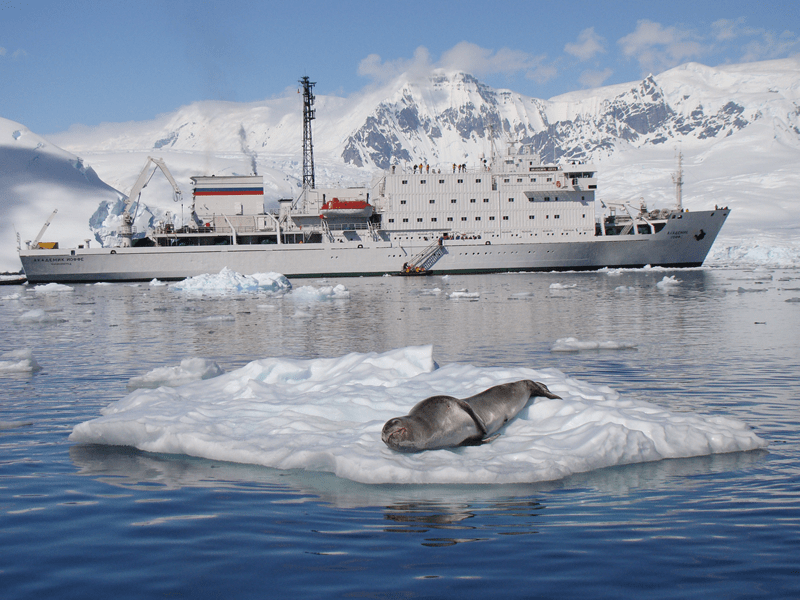Tips from Zelfa
When To Go / Activities / Preparation / Money Matters / Gratuities
When To Go
A common question travelers have is “When is the best time to travel to Antarctica?” The answer depends on what you want to see or do. Keep in mind that you cannot cruise to the Polar regions all year round. Travel is restricted to the austral spring and summer, when daylight lasts between 18 and 24 hours each day. In Antarctica this is from October to March.

From October to the beginning of December

From December through February

From Mid-February to March

When To Go
You arrive in either Ushuaia, Argentina, or Punta Arenas, Chile, by international flight from any major city airport around the world. We usually encourage passengers to plan a minimum of two days of travel in case of lay-overs or unexpected airline delays.
Activities

Camping

Climbing

Kayaking in Antarctica
Preparation
Weather
Wind and weather conditions, can make it seem colder. Daytime temperatures frequently drop below freezing.
Boots
Pants
Hat and Scarf
Outer Clothing
Knapsack or Backpack
Swimsuit
Passport
If you do not have a valid passport please apply for it well in advance of your departure.
Expedition Documents
Clothing
not recommend clothing made of cotton. Plan to dress in layers.
Parkas
Gloves
Socks
Underclothing
Shoes
Additional Useful Gear
- Ear plugs – often useful for hotels or, if your cabinmate snores!
- Small medical kit containing prescription medicines and over-the-counter medication for basic ailments such as stomach upsets, allergies, headaches and seasickness.
- Plastic bags with zipper style closures for carrying film, camera, etc.
- Protective sunscreen for face, lips and hands.
- Good pair of binoculars for spotting wildlife.
- Sunglasses with UV protection.
- Camera, extra batteries and twice the amount of film or memory cards you think you may need.
- Extra pair of prescription glasses, even if you wear contacts.
- Electrical converter with adapter plug set, 220v/110v.avion
- Snow poles or trekking poles.
- Spare prescription glasses if worn.
CabinTags
Disembarkation
MONEY MATTERS
Currency on Board
Payment System
This will include bar services, laundry, postage, and communication charges. A ‘chit’ system will operate for on board payments. You will sign for any bar, wine, communication charges, laundry, etc. An account for payment will be presented to you on the final day of the voyage. Final payment can be made using cash, travelers’ checks or major credit cards. Personal checks are not accepted on board. If you are sharing a cabin and would like separate accounts, you must advise the Hotel Manager.
Gratuities
The voyage price does not include the customary gratuity to the ship’s personnel, which is divided amongst the crew, Expedition Team and Hospitality Team.
We suggest this guideline for your convenience: aboard ship US $11 to US $13 per traveler, per day. The amount you choose to give is at your discretion. It can be added to your shipboard account.
Here are a few guidelines that you will be asked to follow. More detailed instructions (IAATO (International Association of Antarctica Tour Operators) Recommendation XVIII-1 Visitors Guidelines) will be provided in your final documents.
- Always wash your boots on the ship before and after each landing.
- Standing still for long periods of time can be of great benefit when viewing wildlife. Protecting Fragile Vegetation
- Do not try to make an animal react for a photograph.
- Keep quiet – do not make loud or sudden noises.
- avion Birds flying or calling overhead signifies you are too close to a nest or young chicks. Retrace your steps the way you came.
- Avoid coming between an animal and the shore or ocean. Be Aware of your Surroundings
- Fur seals are usually dangerous, therefore keep a greater distance than 5 meters from them at all times.
- Keep a minimum distance of 5 meters (15 feet) from all animals – especially nesting birds.
- Anything that you carry to a landing should be returned to the ship. Safe Behavior Near Wildlife
- No littering, souvenir collecting, or urinating ashore.
- Do not walk onto glaciers – there may be hidden crevasses.
- If you hear the ship’s horn or a Team member asks, you must return to the landing site immediately.
- Do not delay others – return to the landing site prior to the appointed time of departure.
- Listen and obey Expedition Team instructions.
- Keep track of time.
- Never wander off alone or out of sight of the Team positioned ashore.
- Maintain visual contact with Team members.
- No smoking ashore.
- Avoid taking items ashore that could become accidental litter: film boxes, tissues, etc.
- Do not touch animals.
- If an animal’s behavior changes – you are too close. Although the animal may not show obvious fear, they could still be distressed. Remember, if a bird leaves its nest, the eggs or chicks are at risk.
- Always give wildlife the right of way.
- Move slowly and always check behind you.
- Do not make sudden movements.
- Keep low if possible – you will appear less threatening to animals and it will also yield better photographs for you.
- Patience yields the best rewards.
- Avoid walking on moss beds, lichens, or grasses. They are very delicate and slow growing.
- Leave nothing but foot prints.


